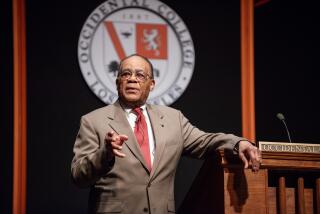James M. Nabrit Jr.; Rights Leader
- Share via
WASHINGTON — James M. Nabrit Jr., an educator and leader in the civil rights movement who argued and won one of the country’s landmark desegregation cases and later served as president of Howard University, died Saturday. He was 97.
A son, James M. Nabrit III, said Nabrit had been under treatment for an infection at his home in northwest Washington when he became seriously ill and was taken to Walter Reed Army Medical Center.
In addition to serving as Howard’s second black president, from 1960 to 1969, Nabrit was dean of the university’s law school for 10 years. From 1965 to 1967, he took leave from Howard to serve as U.S. ambassador to the United Nations.
Nabrit was part of the nucleus of lawyers who in the 1940s and ‘50s led a determined attack on laws that supported segregation. Those efforts eventually brought about a legal revolution that transformed American society.
Nabrit joined Howard’s law school faculty in 1936, and two years later began to teach the first formal course in civil rights law at a U.S. law school. During his tenure, the law school served as a strategy center for the attack on the system of law that maintained a segregated society.
One of the milestones in Nabrit’s career and the nation’s legal history was the case he took to the Supreme Court in the early 1950s that successfully challenged the segregated system of public education in the District of Columbia.
The case, Bolling vs. Sharpe, was argued along with the celebrated Brown vs. Board of Education case. In Brown, argued by Thurgood Marshall, the high court ruled that segregated public education in the states violated the Constitution. The Bolling case applied to the District of Columbia, which Congress governed.
The cases were argued and reargued before the Supreme Court at the same time, and the decisions in each were handed down simultaneously.
“We were all happy,” Nabrit’s son recalled. “There was a general feeling of euphoria, tempered by the understanding that it was going to be tough to make the whole Jim Crow system change.”
James Madison Nabrit Jr. was born Sept. 4, 1900, in Atlanta, the oldest of eight children of a clergyman. He received a bachelor of arts degree in 1923 from Morehouse College in Atlanta, and four years later he received a law degree from Northwestern University law school in Chicago.
In breaks from law school, he began a career as an educator, teaching at Leland College in Baker, La., from 1925 to 1928. After obtaining his law degree, he held the post of dean of the Arkansas State College for Negroes, in Pine Bluff, from 1928 to 1930.
He then practiced law in Houston, handling about two dozen civil rights cases, several involving the right to vote in primary elections. Nabrit was credited with helping to abolish the so-called white primary election in Texas.
As part of the process of organizing the civil rights law course he taught at Howard, Nabrit gathered more than 2,000 cases on the subject from all over the nation. Study of the arguments and the rulings in these cases was pivotal to the development of the strategy for the attack on segregation through the courts.
As president of Howard, Nabrit withdrew from direct participation in the movement to topple legally sanctioned segregation. But he made it clear that his convictions had not changed.
In addition to his son, a former associate director-counsel of the NAACP legal defense and educational fund, he is survived by two brothers and three sisters.
More to Read
Sign up for Essential California
The most important California stories and recommendations in your inbox every morning.
You may occasionally receive promotional content from the Los Angeles Times.












